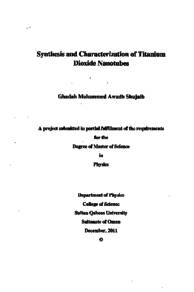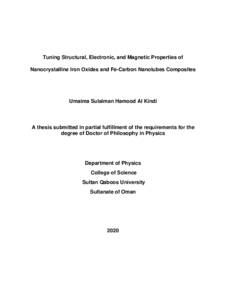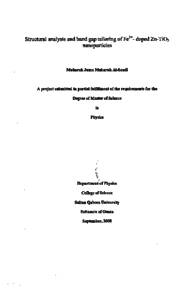وثيقة
Sythesis and characterization of titanium dioxide nanotubes
الناشر
Sultan Qaboos University
ميلادي
2011
اللغة
الأنجليزية
الملخص الإنجليزي
This work aimed to characterize titanium dioxide (titania) nanotubes synthesized by anodization method. The morphology and surface composition of the prepared samples were investigated using SEM, AFM and XPS techniques. Several parameters were applied to synthesize titania nanotubes from Ti foil anodized in 3.5 M HCl dissolved in 1-propanol and 0.3 w% NH4F dissolved in ethylene glycol and 2 v% DW (deionized water). For the first electrolyte solution, long nanotubes were obtained when the foil was anodized at 90 V for 35 min at foil-cathode separation of 2.3 cm. However, anodizing the Ti foil in the second solution at foil-cathode separation of 1.3 cm and anodizing potential and time of 60 V and 2 h respectively led to formation of bundles of defected tubes. Surface roughness was investigated for nanotubes synthesized by two steps of anodization in 0.25 w% NH4F dissolved in ethylene glycol and 1 v% DW. It was found that the nanotubes grown during the second step of anodization exhibit smoother surface and have larger circumference than those grown during the first step. Angular dependent XPS analysis revealed that the composition of the structures grown during the anodization process varied with depth. The analysis indicated that the composition of the anodized samples was affected by the electrolyte solution components. On other words, some of the electrolyte ions such as C, Cl and N can be introduced within the anodized structures as dopants. Moreover, the presence of surficial and molecularly adsorbed species revealed in the XPS spectra infers that some of the electrolyte molecules were trapped within the grown structures.
المجموعة
URL المصدر
الملخص العربي
هدف هذا العمل إلى دراسة خصائص أنابيب النانو لمادة ثاني أكسيد التيتانيوم المحضرة على طريقة التصعيد. و قد استخدمت تقنيات XPS و AFM و SEM لدراسة مورفولوجية و مكونات سطح العينات. عدة عوامل تم تطبيقها خلال عملية تصعید صفائح التيتانيوم في محلولي M HIC 3 . 5 مذاب في 1-بروبانول و 0 . 3w % HNAF مذاب في إيثيلين جليكول و % 2v ماء. نتج عن تصعيد صفائح التيتانيوم في المحلول الإلكتروليتي الأول أنابيب نانو طويلة عندما كان جهد و زمن التصعيد مساويان ل 90 فولت و 35 دقيقة و كانت المسافة بين الصفيحة و المهبط 2 . 3 سم. بالمقارنة نتج عن عملية التصعيد في المحلول الثاني تحت جهد مقداره 60 فولت لمدة ساعتين و فرق مسافة بين صفيحة التيتانيوم و المهبط حزم من الأنابيب مشوهة التركيب. كذلك تم دراسة خشونة سطح أنابيب النانو المصنعة عن طريق مرحلتين من التصعيد في محلول مكون من 0 . 25w * HNAF مذاب في إيثيلين جليكول و ماء. وجد أن أنابيب النانو الناتجة من المرحلة الثانية من التصعيد تملك سطحا أنعما و محيطا أوسعا من تلك التي نتجت من المرحلة الأولى. أظهر تحلیل XPS الزاوي أن مكونات التشكيلات التي تمت خلال عملية التصعيد قد تغيرت مع العمق. وقد بين التحليل أن مكونات العينات المحضرة قد تأثرت بمحتويات المحلول الإلكتروليتي المستخدم خلال عملية التصعيد. أي أنه من الممكن تطعيم التشكيلات النامية بأيونات المحلول مثل الكربون و الكلور و النيتروجين. إضافة إلى ذلك, بل وجود الفصائل السطحية و الممتصة التي ظهرت في أطياف XPS على أن بعض جزيئات المحلول الإلكتروليتي قد حبست في تجويفات العينات المحضرة.
قالب العنصر
الرسائل والأطروحات الجامعية



